View in other NatureServe Network Field Guides
NatureServe
Montana
Utah
Wyoming
Idaho
Wisconsin
British Columbia
South Carolina
Yukon
California
New York
Giant Sulphur - Colias gigantea
General Description
Variously considered a subspecies of Colias scudderi and a full species (Klots 1940; Ferris and Brown 1981; Scott 1986; Ferris 1987; Guppy and Shepard 2001; Pyle 2002; Hammond and McCorkle 2008). The subspecies of C. gigantea considered most prevalent and widespread in Montana has recently been renamed from harroweri to kohleri, both still retained as subspecies of C. scudderi (Hammond and McCorkle 2008), with kohleri perhaps originating through hybridization between C. scudderi and C. occidentalis and converging in appearance to C. gigantea! Given the taxonomic uncertainty and instability, this account probably includes information pertaining to more than one species.
[From Ferris and Brown 1981; Scott 1986; Opler and Wright 1999; Glassberg 2001; Pyle 2002] Forewing 2.4-2.8 cm. Medium sized. Wing fringes yellow tinged with pink in male, all-pink in female. Uppersurface of male yellow with narrow and complete black border, lower edge of forewing straight; females dimorphic, pale yellow form (often) and white form, both with black border often reduced or absent to apically pronounced in the forewing. In both sexes, undersurface of forewing lacking submarginal black spots or patches, hindwing undersurface with large pink-rimmed and elliptical cell spot (wider than high), often with small satellite spot above it.
Phenology
One flight; late June to August (Scott 1986). Mainly July to mid-August (Glassberg 2001). Late July to August in the Rocky Mountain states (Ferris and Brown 1981; Ferris 1987), late June through July in British Columbia (Guppy and Shepard 2001).
Diagnostic Characteristics
Usually distinguished by a combination of the wing fringes yellow tinged with pink in male, all-pink in female, the uppersurface of male yellow with narrow and complete black borders; female in 2 forms, yellow or white, both may have black border reduced or lacking to apically pronounced in forewing; undersurface without submarginal black spots, hindwing with large pink-rimmed and elliptical cell spot (wider than high), often with small satellite spot above it.
Species Range
Montana Range
Range Descriptions
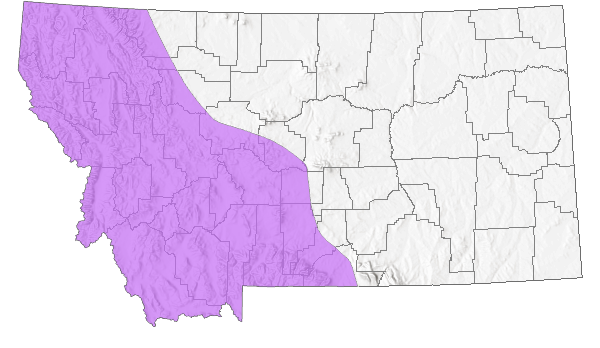
 Native
Native
Range Comments
Northern Alaska east to Northwest Territories and across boreal Canada to northern Manitoba and Ontario, south in the Rocky Mountains to British Columbia, Idaho, Montana, and northwestern Wyoming; isolated population in Cypress Hills of Alberta/Saskatchewan (Ferris 1987; Opler and Wright 1999; Glassberg 2001); 2012 m to 2743 m elevation in Wyoming (Klots 1940; Ferris 1987), about 1829 m elevation in Idaho and Alberta (Ferris 1987), near sea level in the Arctic (Oosting and Parshall 1978; Ferris 1987). In Montana, reported from at least 9 western counties east to Carbon County (Kohler 1980; Stanford and Opler 1993; FLMNH Lepidopterists' Society database), 1829 m to at least 3048 m elevation. Rare to uncommon (Glassberg 2001).
Observations in Montana Natural Heritage Program Database
Number of Observations: 2
(Click on the following maps and charts to see full sized version)
Map Help and Descriptions
Relative Density
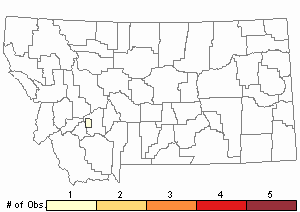
Recency
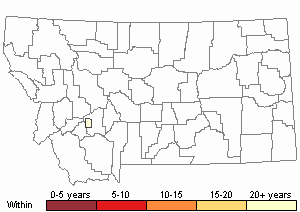
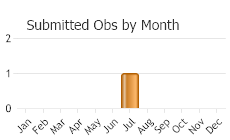
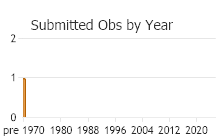
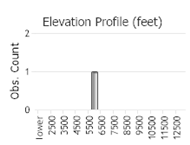 (Observations spanning multiple months or years are excluded from time charts)
(Observations spanning multiple months or years are excluded from time charts)
Migration
Non-migratory.
Habitat
Montane willow bogs, open boggy meadows, riparian bogs, seepage areas in semi-open lodgepole pine forest, tundra and taiga bogs (Klots 1940; Oosting and Parshall 1978; Ferris and Brown 1981; Scott 1986, 1992; Ferris 1987; Opler and Wright 1999; Hamond and McCorkle 2008). In Montana, reported from subalpine meadows, on mountain slopes, along creeks, in hydric montane meadows, always in open dwarf-willow bogs (Hammond and McCorkle 2008; Debinski et al. 2013); in Greater Yellowstone Ecosystem reported from wet willow bogs (Debinski and Pritchard 2002).
National Vegetation Classification System Groups Associated with this Species
Shrubland
Foothills - Montane Shrubland
Wetland and Riparian
Alpine Riparian and Wetland
Riparian and Wetland Forest
Riparian Shrubland
Wet Meadow and Marsh
Food Habits
Limited information. Larval food plants include several species of dwarf Salix inhabiting bogs and wet meadows (Klots 1940; Ferris and Brown 1981; Scott 1986, 1992; Guppy and Shepard 2001; Hammond and McCorkle 2008). Adults feed on flower nectar but flower species often not identified (Ferris and Brown 1981); reported feeding at Pedicularis and Chrysanthemum near Churchill, Manitoba (Oosting and Parshall 1978).
Reproductive Characteristics
Limited information. Females lay egg singly on host plant leaves. Eggs hatch in about 10 days, larvae feed on host plant leaves, diapause (hibernate) as L3 instar, exit diapause, grow to L5 instar, pupate and eclose the following spring or early summer (Oosting and Parshall 1978; Scott 1979, 1986; Ferris 1987; Guppy and Shepard 2001; Hammond and McCorkle 2008). Males patrol throughout the day near shrub willows in search of females (Scott 1986).
Stewardship Responsibility
References
- Literature Cited AboveLegend:
 View Online Publication
View Online Publication Debinski, D.M. and J.A. Pritchard. 2002. A field guide to the butterflies of the Greater Yellowstone Ecosystem. Lanham, MD: Roberts Rinehart Publishers. 107 p.
Debinski, D.M. and J.A. Pritchard. 2002. A field guide to the butterflies of the Greater Yellowstone Ecosystem. Lanham, MD: Roberts Rinehart Publishers. 107 p. Debinski, D.M., J.C. Caruthers, D. Cook, J. Crowley, and H. Wickham. 2013. Gradient-based habitat affinities predict species vulnerability to drought. Ecology 94(5): 1036-1045.
Debinski, D.M., J.C. Caruthers, D. Cook, J. Crowley, and H. Wickham. 2013. Gradient-based habitat affinities predict species vulnerability to drought. Ecology 94(5): 1036-1045. Ferris, C.D. 1987. A revision of the North American Salix-feeding Colias species (Pieridae: Coliadinae). Bulletin of the Allyn Museum 112:1-25.
Ferris, C.D. 1987. A revision of the North American Salix-feeding Colias species (Pieridae: Coliadinae). Bulletin of the Allyn Museum 112:1-25. Ferris, C.D. and F.M. Brown (eds). 1981. Butterflies of the Rocky Mountains. Univ. of Oklahoma Press. Norman. 442 pp.
Ferris, C.D. and F.M. Brown (eds). 1981. Butterflies of the Rocky Mountains. Univ. of Oklahoma Press. Norman. 442 pp. Glassberg, J. 2001. Butterflies through Binoculars: A Field Guide to the Butterflies of Western North America. Oxford University Press.
Glassberg, J. 2001. Butterflies through Binoculars: A Field Guide to the Butterflies of Western North America. Oxford University Press. Guppy, C.S. and J.H. Shepard. 2001. Butterflies of British Columbia: including western Alberta, southern Yukon, the Alaska Panhandle, Washington, northern Oregon, northern Idaho, northwestern Montana. UBC Press (Vancouver, BC) and Royal British Columbia Museum (Victoria, BC). 414 pp.
Guppy, C.S. and J.H. Shepard. 2001. Butterflies of British Columbia: including western Alberta, southern Yukon, the Alaska Panhandle, Washington, northern Oregon, northern Idaho, northwestern Montana. UBC Press (Vancouver, BC) and Royal British Columbia Museum (Victoria, BC). 414 pp. Hammond, P.C. and D.V. McCorkle. 2008. A review of geographic variation and possible evolutionary relationships in the Colias scudderii-gigantea complex of North America (Pieridae). Journal of the Lepidopterists' Society 62(4): 201-215.
Hammond, P.C. and D.V. McCorkle. 2008. A review of geographic variation and possible evolutionary relationships in the Colias scudderii-gigantea complex of North America (Pieridae). Journal of the Lepidopterists' Society 62(4): 201-215. Klots, A.B. 1940. New butterfly subspecies from Wyoming (Nymphalidae, Pieridae). American Museum Novitates Number 1054. 6p.
Klots, A.B. 1940. New butterfly subspecies from Wyoming (Nymphalidae, Pieridae). American Museum Novitates Number 1054. 6p. Kohler, S. 1980. Checklist of Montana Butterflies (Rhopalocera). Journal of the Lepidopterists' Society 34(1): 1-19.
Kohler, S. 1980. Checklist of Montana Butterflies (Rhopalocera). Journal of the Lepidopterists' Society 34(1): 1-19. Oosting, D.P. and D.K. Parshall. 1978. Ecological notes on the butterflies of the Churchill region of northern Manitoba. Journal of Research on the Lepidoptera 17(3): 188-203.
Oosting, D.P. and D.K. Parshall. 1978. Ecological notes on the butterflies of the Churchill region of northern Manitoba. Journal of Research on the Lepidoptera 17(3): 188-203. Opler, P.A. and A.B. Wright. 1999. A field guide to western butterflies. Second edition. Peterson Field Guides. Houghton Mifflin Company, Boston, Massachusetts. 540 pp.
Opler, P.A. and A.B. Wright. 1999. A field guide to western butterflies. Second edition. Peterson Field Guides. Houghton Mifflin Company, Boston, Massachusetts. 540 pp. Pyle, R.M. 2002. The butterflies of Cascadia: a field guide to all the species of Washington, Oregon, and surrounding territories. Seattle Audubon Society, Seattle, Washington. 420 pp.
Pyle, R.M. 2002. The butterflies of Cascadia: a field guide to all the species of Washington, Oregon, and surrounding territories. Seattle Audubon Society, Seattle, Washington. 420 pp. Scott, J.A. 1979. Hibernal diapause of North American Papilionoidea and Hesperioidea. Journal of Research on the Lepidoptera 18(3): 171-200.
Scott, J.A. 1979. Hibernal diapause of North American Papilionoidea and Hesperioidea. Journal of Research on the Lepidoptera 18(3): 171-200. Scott, J.A. 1986. The butterflies of North America: a natural history and field guide. Stanford University Press, Stanford, California.
Scott, J.A. 1986. The butterflies of North America: a natural history and field guide. Stanford University Press, Stanford, California. Scott, J.A. 1992. Hostplant records for butterflies and skippers (mostly from Colorado) 1959-1992, with new life histories and notes on oviposition, immatures, and ecology. Papilio new series #6. 185 p.
Scott, J.A. 1992. Hostplant records for butterflies and skippers (mostly from Colorado) 1959-1992, with new life histories and notes on oviposition, immatures, and ecology. Papilio new series #6. 185 p. Stanford, R.E. and P.A. Opler. 1993. Atlas of western USA butterflies: including adjacent parts of Canada and Mexico. Unpubl. Report. Denver and Fort Collins, Colorado 275 pp.
Stanford, R.E. and P.A. Opler. 1993. Atlas of western USA butterflies: including adjacent parts of Canada and Mexico. Unpubl. Report. Denver and Fort Collins, Colorado 275 pp.
- Additional ReferencesLegend:
 View Online Publication
View Online Publication
Do you know of a citation we're missing? Allen, T.J., J.P. Brock, and J. Glassberg. 2005. Caterpillars in the field and garden: a field guide to the butterfly caterpillars of North America. Oxford University Press.
Allen, T.J., J.P. Brock, and J. Glassberg. 2005. Caterpillars in the field and garden: a field guide to the butterfly caterpillars of North America. Oxford University Press. Brock, J.P. and K. Kaufman. 2003. Kaufman Field Guide to Butterflies of North America. Houghton Mifflin Company, New York, NY 284 pp.
Brock, J.P. and K. Kaufman. 2003. Kaufman Field Guide to Butterflies of North America. Houghton Mifflin Company, New York, NY 284 pp. Caruthers, J.C., and D. Debinski. 2006. Montane meadow butterfly species distributions in the Greater Yellowstone Ecosystem. University of Wyoming National Park Service Research Center Annual Report, 2006. Vol. 30, Art. 14. 85-96.
Caruthers, J.C., and D. Debinski. 2006. Montane meadow butterfly species distributions in the Greater Yellowstone Ecosystem. University of Wyoming National Park Service Research Center Annual Report, 2006. Vol. 30, Art. 14. 85-96. Forister, M.L., E.M. Grames, C.A. Halsch, K.J. Burls, C.F. Carroll, K.L. Bell, J.P. Jahner, et al. 2023. Assessing risk for butterflies in the context of climate change, demographic uncertainty, and heterogeneous data sources. Ecological Monographs 93(3):e1584. https://doi.org/10.1002/ecm.1584
Forister, M.L., E.M. Grames, C.A. Halsch, K.J. Burls, C.F. Carroll, K.L. Bell, J.P. Jahner, et al. 2023. Assessing risk for butterflies in the context of climate change, demographic uncertainty, and heterogeneous data sources. Ecological Monographs 93(3):e1584. https://doi.org/10.1002/ecm.1584 Layberry, R.A., P.W. Hall, and J.D. LaFontaine. 1998. The Butterflies of Canada. University of Toronto Press. 280 pp. + color plates.
Layberry, R.A., P.W. Hall, and J.D. LaFontaine. 1998. The Butterflies of Canada. University of Toronto Press. 280 pp. + color plates. Opler, P.A., K. Lotts, and T. Naberhaus, coordinators. 2010. Butterflies and moths of North America. Big Sky Institute, Bozeman, MT. Available at: www.butterfliesandmoths.org (Accessed 15 June 2015).
Opler, P.A., K. Lotts, and T. Naberhaus, coordinators. 2010. Butterflies and moths of North America. Big Sky Institute, Bozeman, MT. Available at: www.butterfliesandmoths.org (Accessed 15 June 2015).
- Web Search Engines for Articles on "Giant Sulphur"
- Additional Sources of Information Related to "Insects"





